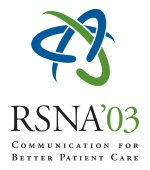
Abstract Archives of the RSNA, 2003
Zeljko Vujaskovic MD, PRESENTER: Nothing to Disclose
Abstract:
ID # 230007
aperr
savage
2
41
2003-11-04T22:22:00Z
2003-11-12T20:35:00Z
2003-11-12T20:35:00Z
1
582
3319
Computer Services
27
6
4075
9.3821
6 pt
2
2
Purpose: A recent study demonstrated that a novel small
molecular weight mimetic of Superoxide Dismutase (SOD), AEOL-10113, can serve
as a normal tissue radioprotectant. Its radioprotective properties presumably
derive from its ability to efficiently scavenge a variety of reactive oxygen
species (ROS), blocking initiation and progression of chronic inflammatory
changes induced by ionizing radiation. Interestingly, AEOL-10113 also has
anti-tumor effects. The overall effects of this compound on tumor
radioresponsiveness, given its simultaneous ROS scavenging and anti-tumor
mechanisms, would be difficult to predict. We, therefore, sought here to
investigate whether AEOL-10113 would serve to increase tumor radioresponsiveness
while protecting normal tissues. Using two distinct combinations of AEOL-10113
with radiotherapy (RT), i.e., administering the drug either before or after
radiation, we examine the potential for additive tumor control, as well as the
effects of differential sequencing on the overall treatment outcome.
Materials and Methods: First flank tumors were established
in the flank of Fischer-344 rats by transplanting an excised portion (a
0.5x0.5x0.5mm cube) of a “donor” R3230 tumor, a syngeneic mammary carcinoma.
Tumors were allowed to reach a mean diameter of 6-8mm before randomization to
treatment groups. Rats were randomized to: (1) no treatment, (2) AEOL-10113
alone (6mg/kg/day, intraperitoneal), (3) radiation alone (21Gty, or (4)
AEOL-10113 (6mg/kg/day, intraperitoneal) and radiation (21Gy). Treatment with
AEOL-10113 began 15 minutes prior to radiation/sham-irradiation. Radiation was
delivered to the tumor-bearing leg, under anesthesia using a single
dorsal-ventral field with 4-MV photons, in a single dose, with a 0.5cm bolus
placed over the tumor. Growth was followed until tumors reached approximately 5
times the original treatment volume. Next, flank tumors were established in the
flank of Balb/C mice by injecting 104 4T1 cells (a syngeneic mammary carcinoma)
subcutaneously. Mice were randomized to +/- AEOL-10113 (6mg/kg/day), +/-
radiation (15Gy in 3 fractions, spaced by 12 hours) once tumors reached a mean
volume of 200mm. Treatment with AEOL-10113 began 15 minutes following the last
dose of radiation/sham-irradiation and continued either: (1) for 3 days, or (2)
for the duration of the study. Growth was followed until tumors reached
approximately 5 times the original treatment volume.
Results: AEOL-10113 alone was more effective in the R3230
model (Tumor Growth Delay = 5 days) than the 4T1 model (Tumor Growth Delay = 2
days). When administered prior to irradiation, AEOL-10113 was as effective as
radiation alone (Tumor Growth Delay =
12 days), but demonstrated no additivity. When administered after irradiation,
AEOL-10113 achieved supra-additive growth delay in both short-term
administration (Tumor Growth Delay = 20 days) and long-term administration
(Tumor Growth Delay = 24 days).
Conclusion: These studies demonstrate that AEOL-10113, an
effective normal tissue protectant, can also serve to increase tumor
radioresponsiveness. However, the sequencing of its administration with
radiation is important. When AEOL-10113 is administered prior to RT, the
potential additivity of this combination is lost. When given after radiation is
complete, AEOL-10113 causes a marked tumor growth delay, significantly greater
than either modality, alone. Interestingly, the crucial window of activity for
AEOL-10113 appears to be in the first few days after RT is complete, as 3 days
of dosing was as effective as an indefinite dosing schedule. As this SOD
mimetic can both protect normal tissues and enhance the anti-tumor effect of
radiation, more investigation is warranted to determine whether (1)
simultaneous administration of AEOL-10113 with fractionated RT, or (2)
sequential administration of RT followed by AEOL-10113 can protect normal
tissues while enhancing tumor curability. (Funding was received from NIH Grant
P30CA14236 and Incara Pharmaceuticals.)
Vujaskovic MD, Z,
Invited Presentation: Sequencing Effects of a Superoxide Dismutase Mimetic on Tumor Radioresponsiveness. Radiological Society of North America 2003 Scientific Assembly and Annual Meeting, November 30 - December 5, 2003 ,Chicago IL.
http://archive.rsna.org/2003/3230007.html

